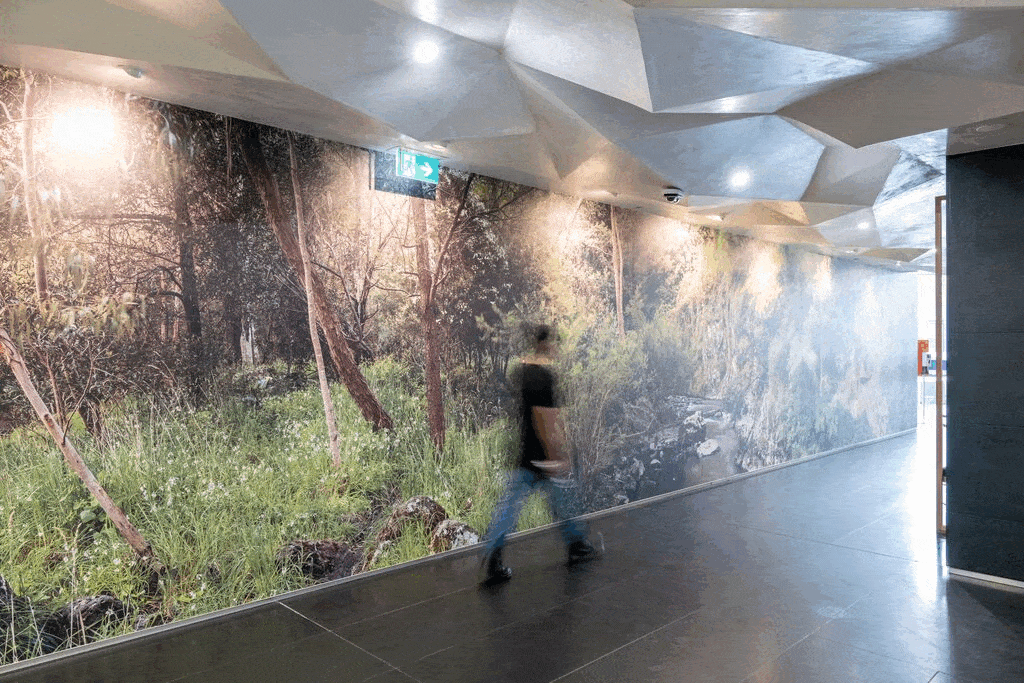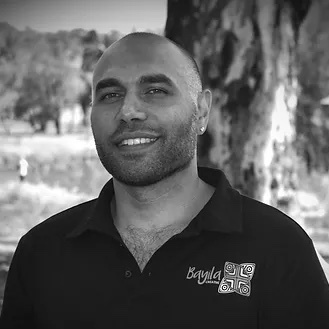An innovative Indigenous art project has transformed the Faculty of Education to recognise the place of Indigenous Knowledges in education and create a culturally safe, welcoming, and respectful environment for Indigenous people.

Breathtaking life-sized photographs, captured by Indigenous photographer James Henry, have been installed on several large walls in the Faculty School buildings.
A symbolic large canvas by Indigenous artist Dixon Patten was also commissioned to express the importance of country and the Faculty's commitment to recognise and prioritise the mutually beneficial exchange of knowledge between Indigenous and non-Indigenous Australians.
Two of the four installations are accessible to the public during business hours:
- Kwong Lee Dow building (Queensberry Street entrance)
- The Eye building (entrance hallway)

Background
The art project was inspired by the University of Melbourne's strategy Advancing Melbourne, with its focus on Place and Community, and the Faculty's Indigenous Development Plan. The working group used these strategies as a springboard for ideation, guided by the thought "how might we create a welcoming environment for Indigenous staff and students?" What began as a few conservative ideas, such as commissioning artwork for use on Faculty publications, quickly grew with the idea put forward by James Henry: "imagine if this [entrance] wall was one giant photograph of the bush."
To guide the project, the working group enlisted the assistance of Wurundjeri Elders, Aunty Julieanne Axford and Aunty Gail Smith. The aunties shared their knowledge of a freshwater stream that once ran down what is now known as Leicester Street (figure 1), where the Graduate School now stands, as well as insights into various locations of meaning that would be appropriate to represent. The working group also yarned with the aunties about Indigenous knowledge systems and ways of knowing and understanding, as well as how some of their aspects can and should be shared and celebrated in the education space.
Inspired by this new knowledge, the working group decided on two deliverables: a series of photographs which would adorn several large walls in the Graduate School buildings and a symbolic large artwork on canvas.
James Henry chose the photographed locations to honour and represent Aunty Julieanne and Aunty Gail's wisdom, and to also convey what country means to him. The aunties yarns about Indigenous Knowledges, Narrm landscapes, and the night sky also informed some of the symbolism that Dixon Patten incorporated into his artwork.
The project team hopes that when Indigenous students and staff enter Faculty of Education buildings, they will see these enormous works and the accompanying words and feel acknowledged, respected, and welcomed. They also wish for all visitors to recognise and reflect on the fact that beneath the Graduate School's concrete foundations are the unceded lands of the Wurundjeri People.
Project team
Artists

Dixon Patten
Dixon Patten is a proud Gunnai, Yorta Yorta, Gunditmara, Dhudhuroa man - he is an artist, designer, mentor, influencer and a strong community advocate. His artistic practice is informed through a strong cultural value that his family and community have imprinted into his mind, heart and spirit. He describes his narratives as being informed by Deep Listening or in his native Yorta Yorta language ‘Gulpa Ngawul’. He takes his role a storyteller seriously and feels humbled to continue this strong aspect of Aboriginal culture. Dixon has worked for a wide range of community, government, education and Indigenous organisations.

James Henry
James Henry is not only a photographer but a much sought after musician and recording engineer. His music spans country rock, reggae and hip hop. He was also the composer on Freeman the documentary about Olympic champion Cathy Freeman. James' work is in high demand and stands out across diverse areas of photography — he beautifully walks that fine line between being invisible and engaging as he works. He has worked for many organisations including the City of Melbourne and many local councils, for the Department of Premier and Cabinet, The Lowitja Institute and the Long Walk Foundation.
Wurundjeri Elders
- Aunty Julieanne Axford
- Aunty Gail Smith
Faculty staff
- Genevieve Costigan
- Melitta Hogarth (Kamilaroi)
- Zane Kingi (Nganduwal/Minjungbal)
- Dale Wandin (Wurundjeri)
Installation
- Hector Henriquez (Visual Graphics)
Image gallery
-

Artwork on canvas
Artwork by Dixon Patten -

100 Leicester Street entrance
Darebin Creek, Wurundjeri Country -

915-Level 9 - 100 Leicester Street
Dights Falls, Wurundjeri Country -

Kwong Lee Dow entrance
Darebin Creek, Wurundjeri Country -

100 Leicester Street entrance
Darebin Creek, Wurundjeri Country -

Kwong Lee Dow entrance
Darebin Creek, Wurundjeri Country -

Indigenous art launch event
Artists, James Henry and Dixon Patten -

Indigenous art launch event
Wurundjeri Elder, Tony Garvey, welcoming the audience to Narrm Country -

Indigenous art launch event
Launch event audience